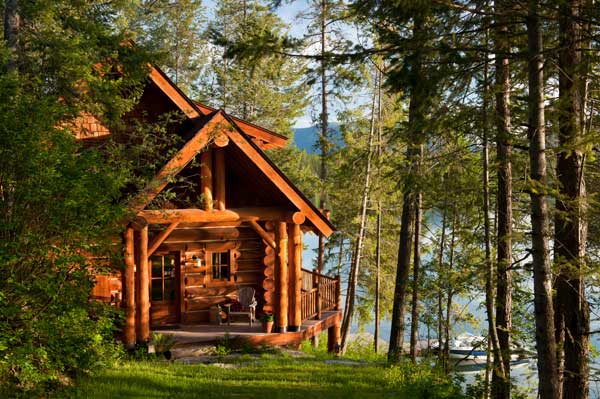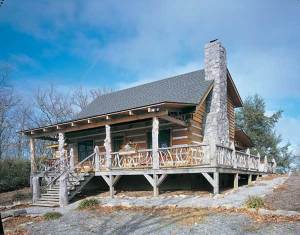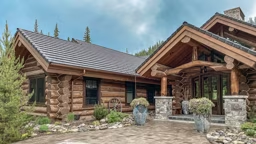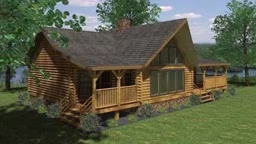There are a lot of decisions that go into choosing, buying and building a log home. Check out our smart log home planning tips and answers to 14 of the most common questions people ask. 
Building a custom log house is an exciting adventure — from the day you start planning to make your dream a reality, to your first night's sleep surrounded by cozy log walls. There are many decisions to make along the way to ensure that the process runs smoothly. First and foremost, you must acquire knowledge about financing, design and construction. That way, you get the house that fits your needs, budget and preferences. Being informed also helps when your dream collides with reality, and you encounter the inevitable: compromise.
Getting Started 
Start by determining how much house you can afford. You'll probably turn to your banker or a mortgage lender who can assist you in two ways. First, they look at your income, expenses and financial situation to calculate how much money you can afford to spend. Second, they will help you establish a building budget. Most people who are building a home will apply for a loan at some point, so while you are thinking about finances, check your credit rating. Your credit history is a snapshot of how you have repaid borrowed money in the past. The rating indicates to your lender the degree to which he is likely to be repaid in full and on time. A credit history covers charge accounts and other credit cards you have, car loans and perhaps, past mortgages. There are several credit reporting agencies. To find one that has your records, ask the officials at your bank. Once you have a clear picture of your financial resources, focus on getting information from the people who will design and build your log house. Then pose these questions from the following categories when making your final decisions:
Finance
1. How much does a log home cost?
This figure varies greatly, depending on the size as well as the quality of the building materials, finishes and fixtures you choose. Be aware that when a log producer quotes you a price, it may cover only the package you devise and there may be additional expenses. Besides the purchase of the land, there's the preparation of the construction site. This can include installing a driveway, leveling the building site, laying the foundation, drilling a well and hooking into local utilities. To get an idea of these expenditures, contact local builders and the municipality where you plan to build. Do, however, turn to the log producer for a ballpark estimate of building any package that interests you. They have years of experience in the field and can help you match the house you want with your budget.
Read more: How Much Do Log Homes Cost?
2. How do I lower my costs?
To get the most for your money, set priorities. Don't skimp on building components that move, such as windows, doors and plumbing fixtures that are continually opened and closed, turned on and turned off. When it comes to selecting fixtures that get used daily, invest in the highest quality you can afford. Once construction is underway, try to stick to your original plan. Changing the design or the materials after you begin building delays the project and increases expenses.
Read more: Smart Budget Strategies for Your Log Home
Design
3. Who makes log homes?
These are companies collectively known as log-home producers; there are more than 400 producers throughout the United States and Canada. The services they provide vary. Some design and build houses, while others only supply the logs necessary for a design by an independent architect or builder. In addition, some companies are nationwide enterprises, usually working via a network of distributors, while others confine their business to certain geographic locales. Finding the producer that's right for you is a great educational experience. Begin by gathering recommendations of both producers and local building contractors from friends who live in log homes. Research the topic by looking at magazines and producers' web sites and call for brochures. Then tour model houses or recently completed homes built by local companies. Whittle down your list by checking the companies' reputations. A good way to begin is to get the names of recent customers and talking to them about their experience: Did the log producer do what he said he would? Was the work completed on schedule? Would you select that particular producer to build another house? If not, why? Be aware, however, that a company is unlikely to give you the name of a dissatisfied customer.Once you've narrowed down your list, contact the Better Business Bureau or the attorney general's office in your state regarding complaints and legal action brought against the log producer you're considering. The Log Homes Council, made up of log-home producers and suppliers, is another resource for names of companies in your area.
Read more: How to Choose a Log Home Producer
4. Where do I find a floorplan that's appropriate for me?
Some people have a fairly good idea of the look and layout they prefer. Others may have only a vague notion. Wherever you fall on that scale, start by compiling a list of features you must have in your new home; for example, the number of bedrooms and baths. Second, supplement the must-haves with the amenities you want to include. You may prefer an open floorplan that combines the living and dining areas into one large room. Even more open is a great room, which unites the living and dining areas with the kitchen into one space. On the other hand, you may go the traditional route of keeping these rooms separate and distinct. What about a family room in place of, or in addition to, a living-dining area? Do you want a den or a study? A bathroom for every bedroom? What about a home office? Also, reflect on the design of your current home. What do you like about the layout? What don't you like?
Read more: The Secrets to Floor Plan Perfection
5. What will my house look like?

The design of your home depends on what it will include, as well as your preferences, budget and the limitations of your building site. Regarding appearance, is your heart set on a two-story home? Are you limited to one story because of local building restrictions or health limitations? Do building setbacks on your plot affect the configuration of your house? Questions along this line of thinking let you separate your needs and wants. You're also establishing a hierarchy, outlining what's most important to you so when you contact an architect or log producer, the process of designing the house is underway already. Of course, the standard models some log producers offer may be perfect for you. Or, perhaps a slight tweaking of an existing design will do the trick. If you don't already own land, look at available sites that appeal to you and your wallet-flat, rolling or on a hillside. Narrow the sites down to two or three; then, if possible, have your architect or designer visit them with you. This gives them the opportunity to mesh the building site and the design of the house seamlessly.
Selecting Logs
6.What type of wood goes into a log home?
There is no single best species of wood for a log home. Some types of wood work better with different construction systems. Some cost more than others, so your selection may be a matter of economics. Still others call for less maintenance over the years. Your choice often boils down to the type of wood your log producer offers or suggests.
Read more: Choosing Wood Species for Your Log Home
7. Does the moisture content of logs matter?
There is no consensus on this question. You essentially have the following options: Timbers that have dried naturally before being cut are called standing dead logs. Cut logs that have undergone a drying process are kiln-dried or air-dried logs. Many people build with "green" logs, which have a high moisture content. Your choice of logs might have an impact on the selection of other building materials, as well as on the construction method. Ask the log producer to advise you on your particular project.
8. Are the logs treated with chemicals? If so, what kind?
Many log producers apply a short- or long-term preservative during the processing stage. As a general rule, a short-term preservative goes on areas subject to high humidity so that the logs will maintain their color during shipping and construction. Even then, the application is done only in warm months. Other log producers apply long-term or permanent preservatives. Usually, these treatments are to prevent wood deterioration caused by insects, mold, mildew and fungus. Preservatives sometimes affect the selection of stains and caulking used to achieve a specific look. Ask the producer whether the logs for your home will be treated and how long the protection will last.
9. Do logs come already cut to size?
A log-home package typically comes in one of two ways. One of those is the precut package. Logs are cut at the processing plant and delivered already sized so that the frame can be constructed without saws and drills. They also may include the convenience of pre-drilled holes for electrical wiring. The second kind includes logs that must be cut to the correct length and notched at the building site. Within this second category, you have two options: a partially precut package or a random-length package. Partially precut logs require less preparation work onsite than the random-length variety. One method is no better than the other. A prepared package is more expensive but quicker to construct, thus eliminating expensive onsite work. If you are planning to complete some of the work yourself, you may prefer to spend less money upfront and invest more time in hands-on work.
10. What are log profiles?
The term "profile" refers to the shape of the logs. The most common are round, square, rectangular and what are called D-logs. Often, these are embellished with curves and beveled edges. The choice of profiles to a great extent determines the appearance of a log home. Ask to see examples of how the logs will look after they are stacked. This result is impacted by several factors: the height and width of the logs; the butt joints, which are the vertical intersections created where the ends of the logs meet; and the horizontal joints established by the intersection of the tops and bottoms of logs. Structural differences between various profiles usually are not a concern. Log-home producers tend to offer an array of log profiles to increase their product's appeal to customers.
Read more: Profiles & Corner Styles for Log Homes
Production
11. What does my log package include?
A complete list of what is included in your package is part of the bill of materials. It is a key element of the contract you sign with the log producer. Review the bill of materials carefully. It should cite a specific and detailed list of not only the materials, but also the services for which you are paying. Look for items such as:* Wood species and grade for all structural components* Type of log profile* Degree of precutting* Moisture content of the logs when they leave the plant* Preservative treatment* Type and number of fasteners* Type, amount and quality of sealants* Grading certificate for the logs, if applicable* Quality, level or grade of all components in the package you select* Number of sets of blueprints included* Cost of delivery and whether it is part of the package price* Cost of each item to compare them with the price of local materialsWhat are purchase agreements? This is the contract you sign with the log producer. It should incorporate the price, payment terms and provisions for canceling the deal. A bill of materials is an important component, as it lists the products and services you are purchasing. The agreement should include written verification of verbal promises and commitments. Be sure the log production company includes the warranty and double-check that warranties for any other products that are included.
Read more: Log Home Package/Kit Options
12. How are logs delivered?
Some log producers include delivery in the price of the package. Others charge for delivery separately, either as a flat fee or a variable fee based on mileage. To track the progress of your delivery, ask whether logs are transported via common carrier or by trucks the company owns. Other questions will come to mind, too. How far in advance does the log producer notify you of the date and time of delivery? Does the driver unload the package, or are you responsible for having the materials removed? Who supplies and pays for equipment to unload the truck? If the truck is late, who pays for the overtime fees and rental equipment? How much space does the truck require for onsite maneuverability?
Construction
13. Who builds log homes?
Think of buying a log-home package and its construction as two separate issues. Some log producers limit their work to making and selling the package. Others not only make and sell the package, but they also build it. Selecting someone to build your home may be a deciding factor in the log producer you choose. For example, if you already have a builder, or plan to build the house yourself, you may want a producer that only supplies the package. But, if you haven't selected a builder, you may choose a producer that doubles as the general contractor. When talking to log producers, find out about the services they offer. If they don't have a network of builders, will they assist your builder? For a fee, some will assemble the components. Others will consult with your builder to ensure the work is completed correctly. This is an important service for owner-builders to know about.
More: See Log Home Living's Directory of Log Home Companies
14. Is one building system better than another?
No particular log construction method is sufficiently superior to persuade you to reject all others. Of all the log-home producers in North America, it's doubtful that any use the exact same combination of methods and materials. Their products have been incorporated into hundreds and, in some cases, thousands of homes. Instead of concentrating on the technical details of log-home construction, focus on how the method complies with the building code in your area. Also, inquire about how the system accommodates settling and whether the logs are graded. After discussing these points with potential log producers, turn inward. You likely have received "vibes" or had gut feelings about the people you have talked to. Do they strike you as being straightforward, competent and honest? Do you feel comfortable talking with them? Can they communicate clearly? Would you trust them to be in your home when you aren't there? Check references and interview former clients. Ask them directly — did the producers do what they said they would, when they said they would and in the way they said they would? Though your relationship with your log producer and builder will be brief, it will be intense. And the result of your collaboration affects the way you live for years, even decades.So, take all the time necessary to make informed, intelligent decisions. Listen to experienced professionals, people who have built their own home as well as your own intuition. The result will be a beautiful, functional living environment that you can call (log) home.








_11868_2024-09-17_08-44-256x288.avif)


